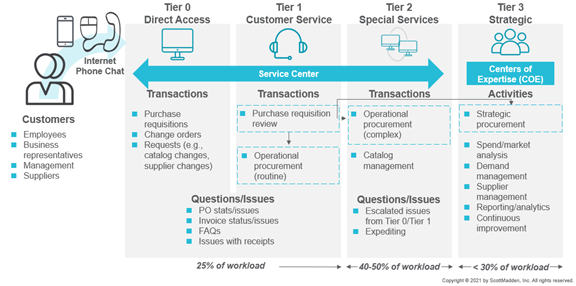
Beginning in the mid- to late-2000s, many procurement organizations evolved from a largely decentralized model to one that is more centralized and focused on strategic procurement activities. As a result, organizations today are looking for improvements through new areas of focus like automation, strategic sourcing, and category management. However, challenges including unclear roles, ineffective uses of technology, and poor customer service continue to plague procurement and the procure-to-pay (P2P) process in many organizations.
In October 2021, APQC hosted Trey Robinson and John Francis (partners and supply chain co-leads) from ScottMadden for a webinar to discuss leading practices in procurement transformation. Robinson and Francis provided insights and guidance related to:
The following provides an overview of the webinar and includes links to articles that explore Francis’ and Robinson’s guidance in more detail.
Access the complete article series here.
Since the mid- to late-2000s, the emphasis on procurement has shifted in many organizations, from administrative and transactional activities to strategic activities. This shift has led to the development of new procurement service delivery models that “align the organization to the work being performed in a way that efficiently delivers service while also reaping the rewards of strategic buying, category management, and improved productivity, efficiency, and technology enablement,” according to Francis. As part of this shift, procurement groups have started to understand their impacts on accounts payable (AP) in a deeper way, which has led both procurement and AP to move toward an end-to-end P2P process.
| Learn more about centralization and governance for P2P: |
To coordinate process improvement activities like standardization and gain visibility over the entire value chain, leading organizations centralize governance of end-to-end processes by identifying a single process owner for each end-to-end process. As Francis explained, centralized governance “drives a stronger mandate toward standardization of policies and processes while still retaining a separate organization to execute the day-to-day operations.”
One important benefit of centralized governance is that it enables organizations to strike a better balance between important operational and strategic areas of procurement. Francis said that leading organizations seek a balanced approach to developing and maintaining three key procurement capabilities:
Centralization through a single process owner is the best governance structure for breaking down silos throughout the P2P process and achieving a healthy balance of focus among these three areas.
Procure-to-pay is a value chain that comprises multiple procurement and finance processes—which means that there are plenty of opportunities for things to go wrong along the way. Francis described three broader symptoms that signal a P2P process is in need of improvement or redesign:
| Learn more about how to identify and address problems in P2P:
» How to Diagnose and Fix Problems with Your Procure-to-Pay Model |
All of these issues have a root cause that generally stems from the design of the end-to-end process model or the structures that support the process. For example, when roles are unclear, strategic procurement employees will likely find themselves spending a lot of their time carrying out transactional tasks rather than providing value-added services or analysis.
Francis presented a tiered service delivery model developed by ScottMadden that addresses these and other common P2P challenges (Figure 1). Roles are clear in this model because procurement activities are defined, measured, and deliberately placed into specific tiers. The tiers are direct access, customer service, special services, and strategic support. Service management technologies like vendor and customer portals, case management tools, knowledge bases, and intelligent workflow tools enable the model and help route work according to clear rules embedded directly into processes.
ScottMadden Tiered Service Delivery Model for Procurement

Implementing a tiered service delivery model for procurement is no small feat. Among other things, this type of procurement transformation requires detailed design to fit your business, sophisticated Project Management, substantive changes to policies and processes, new designs for organizational structure, robust change management, and more. Coordinating all of these activities can easily feel daunting if the transformation is not carefully planned and orchestrated.
Organizations should begin their journey with a comprehensive and thorough assessment of the current state of procurement and move to designing a service model that is customized to your business. Robinson described five inputs that organizations should include in this assessment:
An assessment that includes these inputs helps inform design activities like activity and service placement and policy, process, and procedure alignment in a new model.
| Learn more about implementing a new service delivery model in procurement: |
After designing a new model for procurement, it’s best to organize implementation into a series of distinct but interconnected workstreams. Robinson reviewed six typical workstreams for a service delivery model implementation:
Robinson also described several leading practices and hallmarks of success for an effective service model implementation. For example, defining procurement responsibilities by group helps ensure that procurement tasks can be slotted into their appropriate tier or area as part of a procurement transformation. Organizations should also leverage benchmarks and KPIs before, during, and after the transition to benchmark and track performance throughout the implementation and afterward.
Procurement organizations often see challenges in the P2P process that stem from unclear roles, an overly complex process, or uncertain service channels. The good news is that the steps, strategies, and tools outlined by ScottMadden come directly from successful procurement transformations across a wide range of organizations and industries. Following these approaches enables a smoother and more seamless procurement transformation that delivers higher customer satisfaction and drives more value for the business.
View MoreSussex Economic Advisors is now part of ScottMadden. We invite you to learn more about our expanded firm. Please use the Contact Us form to request additional information.